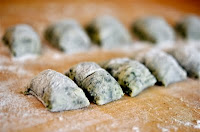 THIS PAST SUNDAY I was faced with a tough choice: catch the last two periods of the gold-medal hockey game between the U.S. and Canada or go for the golden razor clam. I went for the gold. It’s almost always better to be a participant rather than an observer, don’t you think?
THIS PAST SUNDAY I was faced with a tough choice: catch the last two periods of the gold-medal hockey game between the U.S. and Canada or go for the golden razor clam. I went for the gold. It’s almost always better to be a participant rather than an observer, don’t you think?
If you’ve spent any quality time in Jamaica, then rolling sushi ought to be second nature. If not, just practice. A bamboo roller makes it easier. How you cook the rice is key. Make sure you use sushi-grade short-grain rice and rinse it in a few changes of water before cooking. The rice should spread smoothly on a sheet of nori without becoming too gloppy.
While the rice is cooking, prep and arrange your ingredients. I’ve used all kinds of fish, fresh vegetables, Asian-style pickled vegetables, and other flavors and textures. The following are examples, but experiment on your own. Tempura is fun because it adds a little crunch to your sushi and a hit of that fatty goodness that only fried foods can give.

4-5 razor clams, cut in half lengthwise
tempura batter (here’s a recipe)
2 cups sushi rice
seasoned rice vinegar
1 package nori
Dungeness crabmeat or other fish or shellfish*
1 small jar tobiko
1/2 cucumber
1 avocado
pickled ginger
wasabi
soy sauce
* Note: As you can see from the photos, I used fake crab, known as surimi.
1. Make rice. When cooked, mix in a splash of seasoned rice vinegar to taste.
2. Peel and slice cucumber into matchsticks. Cut avocado into thin slices.
3. Batter razor clams and fry in oil. Remove to paper towels.
4. Spread rice evenly on nori wrapper. Repeatedly wetting fingers in a dipping bowl makes this easier.
5. Arrange ingredients and roll. For an inside-out roll, flip rice-covered wrapper onto wax paper, rice side down.



































